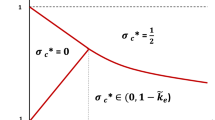Abstract
A model of a rational, sophisticated voter is developed based on the assumption that a voter in a three-candidate election acts to maximize the weighted value of the available voting strategies. The model is used to analyze strategic voting behavior in various traditional and more modern single-ballot systems that employ plurality as a decision rule. In each case, the analysis proceeds by first determining the subset of admissable strategies which are undominated by other valid strategies under the assumption that a voter is not risk-averse. The analysis next involves determining isopreference contours that describe the conditions under which a voter is indifferent between a pair of admissable strategies. These contours are interpreted as decision thresholds which mark the boundaries where a voter shifts from one strategy to another and, hence, govern voting behavior in a particular system. Based on these analyses, an insincerity index, which calibrates the extent to which sophistication produces voting that is inconsistent with actual preferences, is computed. In addition, it is determined for each system whether there are conditions where a group of like-minded, independent voters will vote as a block even though no explicit coalition is formed. Finally, assuming that voting is sophisticated and not risk-averse, we analyze the properties of formal equivalence and symmetry between pairs of systems and, in addition, determine whether a system is formally a mixture of other systems.
Similar content being viewed by others
References
Arrow, K.J. (1951).Social choice and individual values. New Haven, CT: Yale University Press.
Borda, J.C. de (1781).Mémoire sur les élections au Scrutin. Histoire de l'Académie Royale des Sciences.
Brams, S.J. and Fishburn, P.C. (1983).Approval voting. Boston, MA: Birkhauser.
Chamberlin, J.R. and Cohen, M.D. (1978). Toward applicable social choice theory: A comparison of social choice functions under spatial model assumptions.American Political Science Review 72: 1341–1356.
Condorcet, Marquis de. (1785).Essai sur l'application de l'Analyse à la probabilité des decisions rendues à la pluralité des voix. Paris.
Felsenthal, D.S. and Maoz, Z. (1988). A comparative analysis of sincere and sophisticated voting under the plurality and approval procedures.Behavioral Science 33: 116–130.
Gibbard, A. (1973). Manipulation of voting scheme: A general result.Econometrica 1973, 41: 587–601.
Kahneman, D. and Tversky, A. (1979). Prospect theory: An analysis of decision under risk.Econometrica 47: 263–291.
Karmarkar, U.S. (1978). Subjectively weighted utility: A descriptive extension of the expected utility model.Organizational behavior and human performance 2: 61–72.
Lopes, L.L. (1987). Between hope and fear: The psychology of risk. In L. Berkowitz (Ed.),Advances in experimental psychology. San Diego, CA: Academic Press.
Merrill, S. (1981). Strategic decisions under one-state multicandidate electoral systems.Public Choice 36: 115–134.
Merrill, S. (1984). A comparison of efficiency of multicandidate electoral systems.American Journal of Political Science 28: 23–48.
Merrill, S. (1988).Making multicandidate elections more democratic. Princeton, NJ. Princeton University Press.
Merrill, S. and Nagel, J. (1987). The effect of approval balloting on strategic voting under alternative decision rules.American Political Science Review 81: 509–524.
Richelson, J.A. (1976). Comparative analysis of social choice functions.Behavioral science 20: 331–337.
Satterwaite, M. (1975). Strategy-proofness and Arrow's conditions: Existence and correspondence theorems for voting procedures and social welfare functions.Journal of Economic Theory 10: 187–217.
Author information
Authors and Affiliations
Additional information
Supported in part by a Faculty Development Grant from Merrimack College. We wish to thank Patricia Bowman-Skeffington for her valuable assistance in the preparation of this manuscript. We also wish to thank Richard A. Chechile, director of the Decision Making Center of Tufts University, for his valuable comments and for facilitating this work by making the Center available to us.
Rights and permissions
About this article
Cite this article
Gutowski, W.E., Georges, J.P. Optimal sophisticated voting strategies in single ballot elections involving three candidates. Public Choice 77, 225–247 (1993). https://doi.org/10.1007/BF01047867
Accepted:
Issue Date:
DOI: https://doi.org/10.1007/BF01047867




